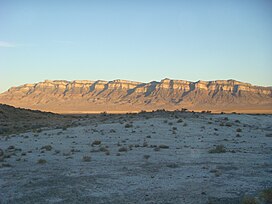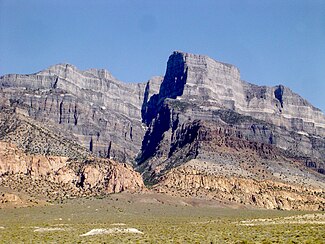House Range
| House Range | |
|---|---|
 Northern part of the House Range at sunset-(Swasey Mountainsection), showing the stratigraphy | |
| Highest point | |
| Peak | Swasey Peak |
| Elevation | 9,669 ft (2,947 m) |
| Coordinates | 39°23′17″N113°18′59″W/ 39.388142°N 113.316408°W |
| Dimensions | |
| Length | 70 mi (110 km) N/S |
| Width | 34 mi (55 km) E/W |
| Area | 1,242 sq mi (3,220 km2) |
| Geography | |
| Country | United States |
| State | Millard County, Utah |

TheHouse Rangeis a north-south trendingmountain rangeinMillard County,of west-centralUtah.The House Range was named in 1859 byJames H. Simpson.It was named by Simpson because "...of its well-defined stratification and the resemblance of portions of its outline to domes, minarets, houses, and other structures."[1]
Geography
[edit]The House Range is bounded byTule Valleyto the west,Whirlwind ValleyandSevier Desertto the east, and trends with theFish Springs Rangeto the north. The range has three notable passes:Skull Rock Pass(whichUS Highway 6/US Highway 50travels through),Marjum Canyon(which the old US Highway 6 travels through), andSand Pass(which theWeiss Highwaypasses through).
The highest point in the House Range isSwasey Peak,at 9,669 feet (2,947 m).[2]Other notable peaks include Notch Peak, a frequent climbing and base-jumping hotspot, and the very squareTatow Knob.
It is also known for one of the tallestlimestonecliffsin the world,Notch Peak.
Geology
[edit]The geology of the House Range is dominated by grayCambriantoDevoniancarbonate rockwhich was intruded by a pinkJurassicgranitoidin the central part of the range. In the Wheeler Amphitheater, away from the intrusion, the Lagerstätte that contains the well-preserved fauna is found in the Cambrian section of the range. Evidence ofLake Bonneville's presence is found both in shorelines and whitemarlsat the base of the range. The main structural component to the range is a large basin-bounding fault on the west side.[3]
Fossils
[edit]The range is known for a fossilLagerstätte(Wheeler Shale) ofCambrianage, which has an array ofBurgess Shale type fauna,includingElrathia kingii,atrilobitethat is one of Utah's most famousfossils.[4][5]
Stratigraphy
[edit]TheSwasey Limestonewas deposited in theBathyuriscus–Elrathinazone(contemporaneous with theBurgess Shale). This is overlain in turn by theBolaspidellazone (uppermost Middle Cambrian)Wheeler ShaleandMarjum Formation,then theCedariazone (lowermost Upper Cambrian)Weeks Formation.[6][7]
References
[edit]- ^Van Cott, J. W., 1990, Utah Place Names,ISBN0-87480-345-4
- ^"Feature Detail Report for: Swasey Peak".USGS.
- ^Chronic, Halka (1990).Roadside Geology of Utah.ISBN0-87842-228-5.
- ^"Localities of the Cambrian: The House Range UCMP".
- ^"House Range".Peakbagger.RetrievedJanuary 13,2013.
- ^Robison, R. A. (1964). "Upper Middle Cambrian Stratigraphy of Western Utah".Geological Society of America Bulletin.75:995–1010.doi:10.1130/0016-7606(1964)75[995:UMCSOW]2.0.CO;2.ISSN0016-7606.
- ^"House Range Cambrian Stratigraphy".fossilmuseum.net.Retrieved14 October2013.


